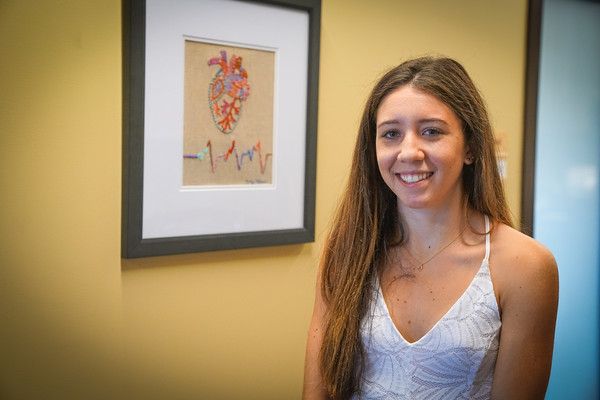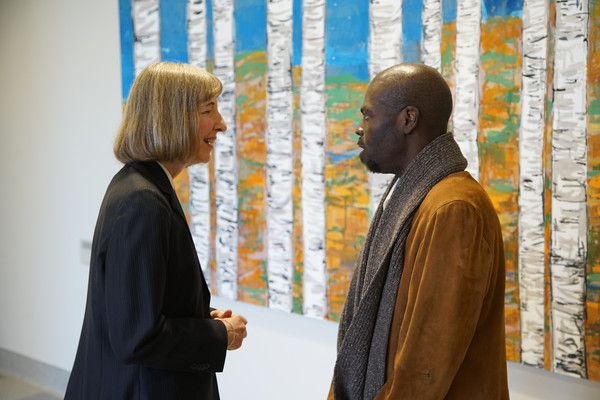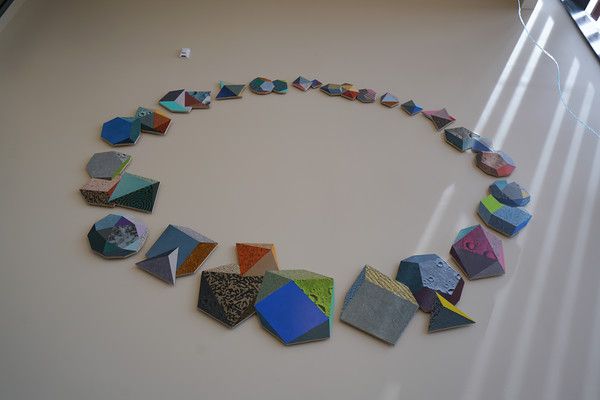The first time you step into the Scott Bieler Clinical Sciences Center at Roswell Park, you might assume you’ve entered an upscale art gallery. Overhead in the main lobby, a cluster of copper-colored spheres suggests the wispy seed heads of dandelions. An oil painting of birch trees against a green-and-gold background creates a feeling of early fall.
Around every corner on every floor, surprising images, colors, and textures stir visitors’ curiosity and imagination. That’s the goal: using art to “provide the distraction and inspiration to help patients focus on something else when they’re having a really difficult time,” says Dana Jenkins, MS, Vice President of Organizational Performance Improvement at Roswell Park.
Jenkins, a noted watercolorist whose paintings have been widely published, was asked to organize and lead a team of seven people who selected, purchased, organized and installed the works. They visited area studios and viewed slides of artists’ work to find the right pieces for the brand-new building. The all-volunteer committee included people with strong connections to Roswell Park and the local art community — some with professional experience in choosing, installing and organizing works of art.
The collection they assembled will attract people with a broad range of tastes. It includes “a lot of watercolor, because Buffalo is a big watercolor town, and some oil paintings,” Jenkins says. "There’s some sculpture. There’s a lot of mixed media. There’s photography.”
The project was funded by gifts to the Roswell Park Alliance Foundation to support the Institute’s art collection. Susan Zebro, chair of the Alliance Art Committee, says artwork was key to providing a warm and comforting atmosphere in the current Roswell Park hospital when it opened its doors in 1998. “Patients and their families appreciate how art transforms their experience here,” says Zebro. “Now donors are helping create the same environment in the new center next door.”
Spotlight on Western New York artists & real-world imagery
The Art Committee “has a policy that we focus on Western New York artists, and that we never buy without the artist either donating to the collection or giving us a serious discount,” notes Jenkins. That means every penny donated is spent carefully.
Throughout the selection process, the committee was guided by input from the same patient volunteers who had influenced the layout and design of the new center. Jenkins says when it came to artwork, they “wanted to see something they could recognize and identify with,” rather than abstract pieces. So, while some of the art is abstract, most of it reflects the real world, “something that lets your mind go off into a different place.”
The success of that philosophy has led to some inspiring stories. Jenkins recalls how members of one patient’s family were having trouble talking about their loved one’s diagnosis. As they sat together in the waiting room, one of them noticed a painting that looked like a favorite place in Canada where they had vacationed together, and asked, “Are we going to the lake this year?”
That question, set off by a familiar scene in a painting, “started a whole conversation about the future and what they wanted it to be, and what they could do to shape that future,” Jenkins says. “It was great.”
Stay tuned for an upcoming series of interviews with some of the artists whose work is displayed in the Scott Bieler Clinical Sciences Center.



